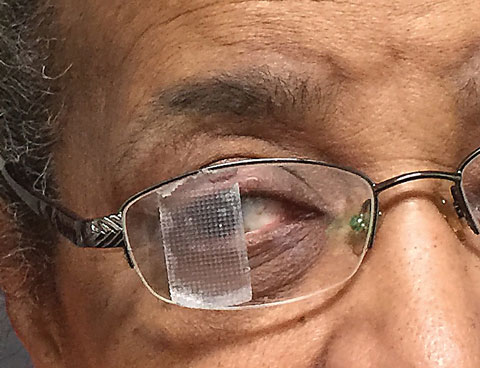 |
One of the most common ocular findings following an acquired brain injury, such as stroke, is diplopia. Not only is it disorienting for the patient, it also interferes with the rehabilitation process. Considering improvement immediately following a stroke is essential to the patient’s long-term overall life outcome, eliminating the diplopia is a vital first step. Before we made diplopia a priority at our rehabilitation facilities, it was common to find patients doing rehab therapies while still wearing the dreaded black patch. Although patching treatment does the trick to eliminate double vision, it inhibits the brain’s ability restore the visual system to fusion. Luckily, far superior options are available.
Case Example
A 71-year-old African American female presented to a local emergency room with complaints of double vision. Radiologic studies confirmed a stroke. At the time of our examination, she was undergoing rehabilitation to improve activities of daily living. She reported double vision that was horizontal, vertical or both, and variable. She had been self-patching to eliminate the double vision. She was wearing a progressive bifocal.
Distance visual acuities were taken at six feet—standard for a visit at a rehabilitation center due to the patient’s prone positioning—and measured 20/20 OD and 20/50 OS. Because the patient was tilting her head while lying in bed during the exam, we surmised she was looking through the incorrect portion of the PAL. Pupils were normal with no APD. Confrontation fields were full-to-finger count. Cover test showed a constant right exo/hypotropia in the patient’s right eye. Eye movements showed the patient’s left eye was restricted to the right and her right eye restricted in upgaze; movement was of poor quality with numerous fixation losses. The anterior and posterior segment evaluation revealed no issues.
Achieving Fusion: Keep it Simple
Although we typically start with prism to attempt fusion, this patient’s variable double vision made finding the right power and direction of prism impossible. With our next option, occlusion, we sought to implement an important overarching concept: use the least amount of occlusion possible to reduce or eliminate the double vision. For example, we have used binasal occlusion, spot occlusion and monocular full lens occlusion in the past. For this patient, simply putting a strip of tape down the center of the right lens eliminated her double vision as long as she turned her face toward objects she was trying to view.
 |
| Shown here is the patient with tape placed in a variation of the initial proper position, with the tape placed on the right half of the right lens. |
In addition to educating the patient’s therapists on this simple therapy, we also instructed them on eye stretches to keep all of the muscles from suffering contracture. We want to get the eyes moving in all directions as far as possible. When an eye shifts to a new location in the head for too long, the muscle that is dominating can actually shorten in length. This makes recovery harder should the affected muscle begin to come back to life. So, eye stretches help to keep the system as mobile and adaptable as possible. The patient was instructed to follow up with us upon release from the rehabilitation center.
A Bump in the Road to Recovery
A few days later, the patient showed up again on our patient list at the rehabilitation hospital. Upon entering the room, we observed the patient without her glasses, squinting her right eye shut. When asked where the glasses were, she pointed to the table. In spite of Dr. Taub putting the tape on the right lens, it was now clearly down the center of the left lens. A number of family members were present, and one said that our patient’s daughter, who was not present, had moved the tape.
Although the family was hoping for prism, extensive testing showed that 25D of base-in prism only gave her single vision in primary gaze in one specific direction of gaze and at one specific distance in space. Her non-concomitants (variable degrees of turn in different positions of gaze) made it impossible for her to see within a large volume of space. She also complained about the distortions caused by the Fresnel prism of that magnitude.
We decided to return to a variation of Dr. Taub’s treatment plan and put tape on the right half of the right lens. The variation from the initial placement directly in front of her right eye most likely was due to some changes in her eye posture and restrictions due to minor recovery between visits. This made it much easier for her to find an object and rotate her head to just the right place to tuck the second image behind the tape.
This time, the entire family, except for the enterprising daughter, was present to learn about the patient’s treatment plan. (Dr. Harris spoke to the daughter over the phone the next day.)
Having members of the rehab team and the patient’s family all on the same page was crucial for this patient’s long-term success. Since her discharge from the rehab hospital, the patient has been coming regularly for vision therapy.
This case shows a little bit of tape can go a long way—but it needs to be in the right place, and patients, staff and even family members need to be educated on this simple but effective modality.

